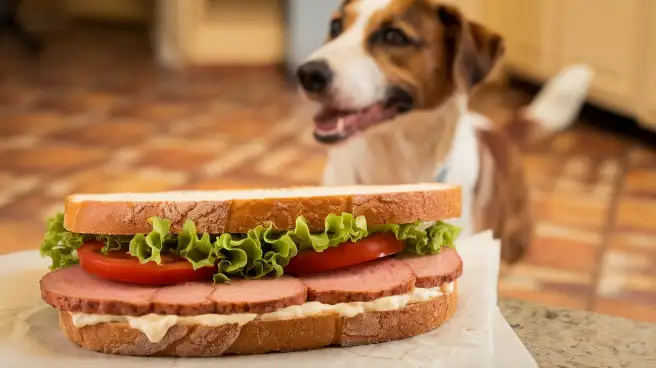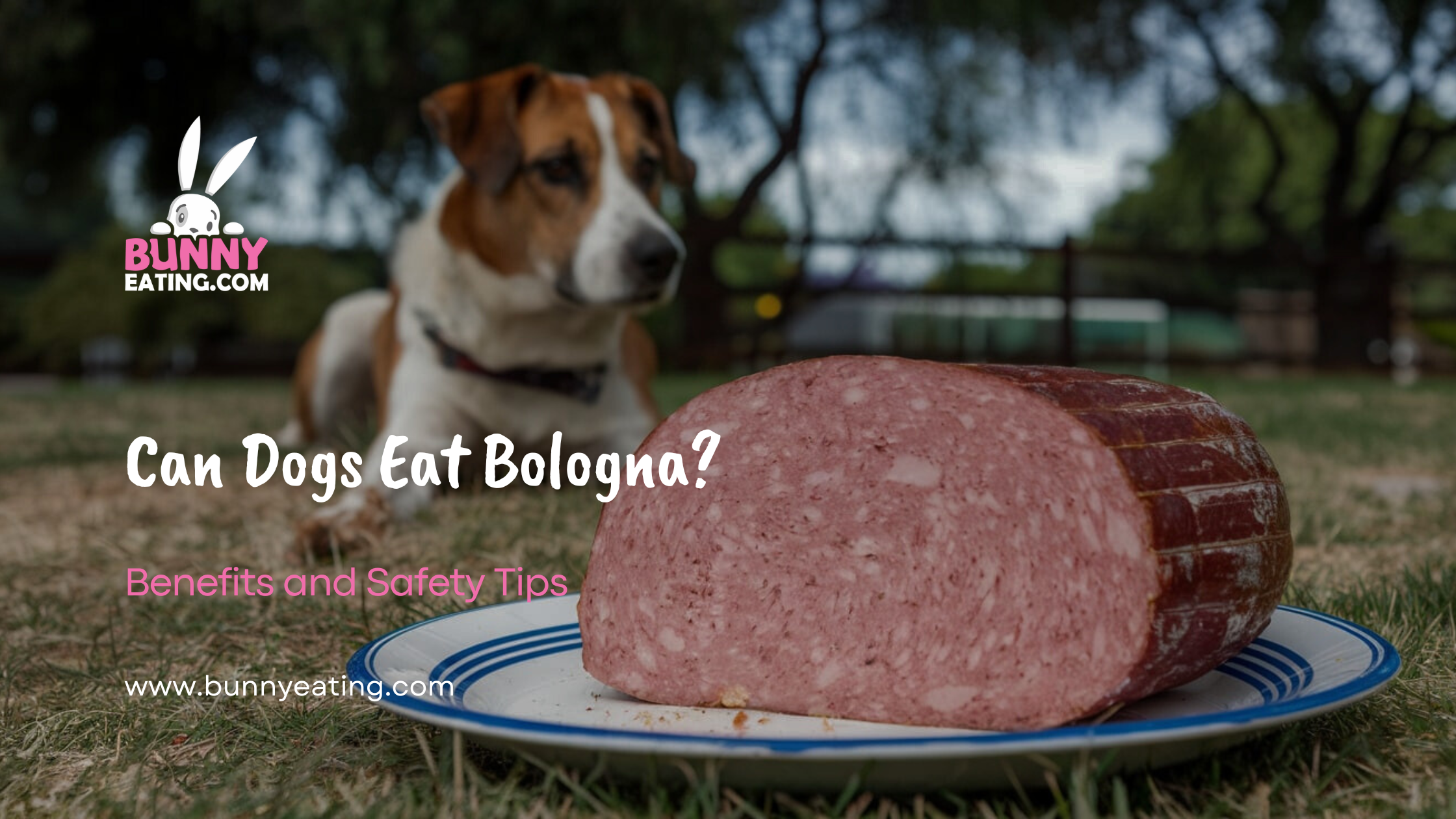The short answer to “Can dogs eat bologna” is yes, they can, but they probably shouldn’t. Think of bologna as the canine equivalent of junk food. Sure, a tiny piece as an occasional treat likely won’t send your pup to the emergency vet, but it’s far from being a health food for dogs. Bologna is packed with fat, sodium, and other additives that don’t do your four-legged friend any favours in the long run.
When considering the safety of bologna for dogs, it’s important to remember that what’s safe for humans isn’t always safe for our pets. Dogs have different nutritional needs and sensitivities compared to us. While we might enjoy a bologna sandwich without ill effects, our dogs’ bodies aren’t designed to handle the high levels of fat, salt, and preservatives found in this processed meat. It’s like giving a toddler a coffee – sure, they might like it, but it’s not exactly what the paediatrician ordered.
Table
ToggleIs Bologna Bad for Dogs?
Let’s not sugarcoat it – when it comes to canine nutrition, bologna isn’t winning any awards. It’s high in calories, fat, and sodium, which can lead to a smorgasbord of health issues for your furry friend. We’re talking about weight gain, heart problems, and even pancreatitis if they chow down on too much. It’s like letting your dog binge-watch their favourite show while lounging on the couch – fun at the moment, but not great for their long-term health.
But it’s not just about the fat and salt. Many types of bologna contain garlic and onion powder, which are toxic to dogs. And let’s not forget about the nitrates and other preservatives that can upset your pup’s tummy or worse. It’s like a chemical cocktail that your dog’s digestive system just isn’t equipped to handle. So while a small piece might not cause immediate harm, regularly feeding bologna to your dog is like playing Russian roulette with their health.
Can Dogs Eat Bologna Meat?
When we talk about bologna meat and dogs, it’s important to distinguish between plain bologna meat and the processed products we typically find in stores. Plain bologna meat, without any added spices or preservatives, isn’t inherently toxic to dogs. However, it’s still not an ideal food choice for our canine companions. It’s like giving your kid candy for dinner – they might love it, but it’s not exactly what the doctor ordered.
Bologna meat is high in fat and calories, which can contribute to obesity in dogs if fed regularly. Moreover, the salt content, even in plain bologna, is often too high for dogs. While a small piece as an occasional treat might not cause immediate harm, it’s not something you want to make a habit of feeding your dog. Remember, your dog’s diet should primarily consist of nutritionally balanced dog food that meets all their dietary needs.
Can Dogs Eat Fried Bologna?
Now, if regular bologna raises concerns, fried bologna takes those worries and cranks them up to eleven. Frying adds extra fat and calories to an already unhealthy food. It’s like taking a bad situation and making it worse. Your dog’s digestive system isn’t built for greasy, fried foods, so it’s best to keep the crispy stuff to yourself.
Fried foods can cause digestive upset in dogs, leading to symptoms like vomiting and diarrhoea. Moreover, the additional fat from frying increases the risk of pancreatitis, a serious and potentially life-threatening condition in dogs. So while that crispy, fried bologna might smell irresistible to your pup, it’s not worth the risk to their health. Stick to dog-friendly treats that are specifically designed for their nutritional needs.
Can Dogs Eat Bologna With Allergies?

When it comes to bologna and allergies in dogs, it’s a potential minefield. If your dog’s got food allergies, bologna’s probably not their best bet. With its mix of meats and spices, it could trigger an allergic reaction faster than you can say “luncheon meat.” It’s always better to stick with foods you know are safe for your allergy-prone pup.
Dogs can be allergic to various ingredients found in bologna, including beef, pork, chicken, or any of the additives and preservatives. Symptoms of food allergies in dogs can range from mild (like itching or ear infections) to severe (such as difficulty breathing). If your dog has known allergies, it’s best to avoid bologna altogether. Even if your dog doesn’t have known allergies, introducing new foods like bologna can potentially trigger an allergic reaction. Always consult with your vet before adding new foods to your dog’s diet, especially if they have a history of allergies.
When Is Bologna Okay for Dogs to Eat?
Look, we’ve all been there – those puppy dog eyes begging for a taste of your sandwich. If you must give your dog bologna, make it a tiny piece, and make it rare. Think of it as a once-in-a-blue-moon treat, not a regular part of their diet. It’s like that slice of birthday cake – a special treat, not an everyday indulgence.
If you do decide to give your dog a bit of bologna, make sure it’s plain, without any added spices or seasonings. Avoid giving them fried bologna or bologna with garlic or onion powder. Also, consider your dog’s size – a small piece for a Great Dane is very different from a small piece for a Chihuahua. Always monitor your dog after giving them any new food, including bologna, and watch for signs of digestive upset or allergic reactions.
What Are the Risks of Feeding My Dog Bologna?
Feeding your dog bologna isn’t without its risks. From upset stomachs to more serious health issues, there’s a whole buffet of potential problems to consider. Here’s a breakdown of the main risks:
- Obesity: Bologna is high in calories and fat, which can lead to weight gain. Just like us, overweight dogs are at risk for a host of health problems.
- Pancreatitis: Too much fat can inflame your dog’s pancreas. This painful condition can be serious and even life-threatening.
- Salt poisoning: The high sodium content in bologna can cause serious health problems in dogs. Excessive salt intake can lead to dehydration, kidney problems, and in severe cases, sodium ion poisoning.
- Digestive issues: Spices and additives in bologna might upset your dog’s stomach, leading to vomiting or diarrhoea.
- Choking hazard: The casing or large chunks of bologna could pose a choking risk, especially for small dogs.
- Allergic reactions: Some dogs may be allergic to ingredients in bologna, which can cause symptoms ranging from skin irritation to more severe reactions.
- Long-term health issues: Regular consumption of high-fat, high-sodium foods like bologna can contribute to heart disease and other chronic health problems in dogs.
Signs of Sodium Ion Poisoning in Dogs

Sodium ion poisoning in dogs is a serious condition that can occur if your pup consumes too much salt, which is a real risk with foods like bologna. If your dog’s had too much salty bologna, watch out for these red flags:
- Excessive thirst: If your dog’s suddenly draining their water bowl like it’s going out of style, it could be a sign of salt poisoning.
- Frequent urination: Along with increased thirst comes increased bathroom breaks.
- Vomiting: Your dog’s body might try to get rid of the excess salt by vomiting.
- Diarrhoea: Another way the body tries to expel excess salt is through diarrhoea.
- Tremors or seizures: In severe cases, salt poisoning can affect your dog’s nervous system, leading to tremors or seizures.
- Lethargy or weakness: Your normally bouncy pup might become unusually tired or weak.
- Swollen abdomen: In some cases, salt poisoning can cause fluid buildup in the abdomen.
- Confusion or disorientation: Your dog might seem confused or act strangely.
If you spot any of these symptoms, it’s time to call the vet, pronto! Salt poisoning can be life-threatening if not treated quickly.
What Should I Do If My Dog Accidentally Eats a Large Amount of Bologna?
Accidents happen, and if your dog manages to snag a whole pack of bologna while you’re not looking, don’t panic, but don’t ignore it either. Here’s your game plan if you find yourself thinking, “My dog ate bologna, what do I do?”:
- Remove any remaining bologna: First things first, make sure your dog can’t eat any more. Put away any leftover bologna and clean up any pieces that might have fallen on the floor.
- Watch for signs of distress: Keep a close eye on your dog for any unusual behaviour or symptoms like vomiting, diarrhoea, excessive thirst, or lethargy.
- Offer plenty of fresh water: Bologna is high in salt, so make sure your dog has access to plenty of fresh water to help flush out their system.
- Call your vet for advice: Even if your dog seems fine, it’s a good idea to give your vet a call. They can advise you on what to watch for and whether you need to bring your dog in for a check-up.
- Monitor your dog closely: Keep a close eye on your pup for the next 24-48 hours. If you notice any concerning symptoms, don’t hesitate to contact your vet again.
Remember, it’s always better to be safe than sorry when it comes to your furry friend’s health. While a small amount of bologna might not cause immediate harm, a large quantity could lead to serious issues like salt poisoning or pancreatitis.
Is the Red Ring Around Bologna Digestible for Dogs?
The red ring on bologna is often a source of curiosity and concern for dog owners. This red casing is typically made from collagen, which is derived from animal skin or connective tissue. While it’s generally digestible for dogs, it doesn’t mean it’s good for them. The casing often contains additional preservatives and dyes, which aren’t ideal for your pup’s diet.
If your dog happens to eat a piece of bologna with the red ring intact, it’s unlikely to cause immediate harm. However, in large quantities, it could potentially cause digestive upset or even pose a choking hazard, especially for smaller dogs. As with the bologna itself, it’s best to avoid feeding the casing to your dog intentionally. If you do give your dog a small piece of bologna as an occasional treat, it’s safer to remove the casing first.
Can Dogs Eat Bolognese Sauce?
When we talk about bolognese sauce and dogs, we’re entering a different culinary territory from bologna meat. Bolognese sauce is a meat-based sauce originating from Bologna, Italy, typically made with ground beef, tomatoes, and various herbs and spices. While it might sound more “natural” than processed bologna, it’s still not an ideal food for dogs.
Bolognese sauce often contains ingredients that can be harmful to dogs, such as onions and garlic, which are toxic to canines even in small amounts. The sauce is also typically high in salt and fat, which can lead to the same issues as feeding bologna. Additionally, many bolognese recipes include red wine, which is a no-no for dogs. If you’re enjoying a plate of spaghetti bolognese, it’s best to keep it to yourself and offer your dog a dog-friendly treat instead.
Can Puppies Have Bologna?

When it comes to puppies and bologna, the answer is a resounding “no.” Puppies have delicate digestive systems and specific nutritional needs that are crucial for their growth and development. Bologna, with its high fat and salt content, is even more inappropriate for puppies than it is for adult dogs.
Puppies need a balanced diet that’s specifically formulated to support their rapid growth and development. Feeding them bologna or other processed meats can lead to nutritional imbalances, digestive upset, and potentially serious health issues. It’s best to stick to high-quality puppy food recommended by your veterinarian. If you want to give your puppy treats, opt for puppy-specific treats or small pieces of dog-safe fruits or vegetables. Remember, what you feed your puppy sets the foundation for their lifelong health, so it’s important to start them off on the right paw!
Can Dogs Eat a Chicken Bologna Sandwich?
The idea of sharing your chicken bologna sandwich with your furry friend might seem tempting, but it’s not a good idea. While chicken is generally safe for dogs, the bologna and bread in the sandwich can cause problems. The chicken bologna still contains high levels of salt, fat, and preservatives that aren’t good for your dog. Moreover, the bread adds unnecessary carbohydrates to your dog’s diet.
If you want to share a sandwich-like treat with your dog, consider making a dog-friendly version. You could use a small amount of plain, cooked chicken breast (no seasoning) between two thin slices of cucumber or a small piece of lettuce. This gives your dog the fun of eating something sandwich-like without the harmful ingredients. Remember, treats should make up no more than 10% of your dog’s daily calorie intake, with the rest coming from nutritionally balanced dog food.
Safer Alternatives for Dogs
Instead of bologna, there are many safer and healthier alternatives to bologna for dogs. Here are some ideas:
- Small pieces of plain, cooked chicken or turkey (no seasonings)
- Bite-sized chunks of apple (no seeds)
- Baby carrots
- Small pieces of banana
- Blueberries
- Plain, cooked sweet potato
- Commercial dog treats (in moderation)
- Small pieces of cooked, lean beef
- Frozen green beans
- Small pieces of watermelon (no seeds)
Remember, even these healthier options should be given in moderation. Treats should make up no more than 10% of your dog’s daily calorie intake. Always introduce new foods slowly and in small amounts to watch for any adverse reactions.
What to Serve Instead of Bologna?
When looking for what to serve instead of bologna to your dog, it’s best to focus on whole, unprocessed foods that offer nutritional benefits. Here are some ideas:
- Lean meats: Small amounts of plain, cooked chicken, turkey, or lean beef can be a protein-rich treat.
- Fish: Cooked salmon or sardines (packed in water, not oil) can provide healthy omega-3 fatty acids.
- Vegetables: Many dogs enjoy crunchy veggies like carrots, green beans, or cucumber slices.
- Fruits: Apples (no seeds), blueberries, or small pieces of banana can be sweet, healthy treats.
- Commercial dog treats: Look for treats that are specifically formulated for dogs and approved by veterinarians.
Remember, any treats should be given in moderation and should not make up more than 10% of your dog’s daily calorie intake. Always consult with your veterinarian before making significant changes to your dog’s diet.
Types of Bologna and Dogs’ Safety

When it comes to types of bologna, there’s quite a variety out there. But whether it’s beef bologna, chicken bologna, deer bologna, or any other type, the general rule remains the same: it’s not a recommended food for dogs. Let’s break down some common types:
- Beef Bologna: While beef itself isn’t toxic to dogs, the high fat and salt content in beef bologna make it unsuitable for canine consumption.
- Chicken Bologna: Despite chicken being a common ingredient in dog food, chicken bologna is still processed and contains unhealthy additives.
- Deer Bologna: Even though venison can be a novel protein source for dogs with allergies, deer bologna is still processed and high in salt.
- Turkey Bologna: Turkey is often considered a leaner meat, but turkey bologna is still highly processed and not recommended for dogs.
- Lebanon Bologna: This tangy, fermented sausage is even more unsuitable for dogs due to its strong flavours and spices.
- Garlic Bologna: Garlic is toxic to dogs, making this variety particularly dangerous.
- Trail Bologna: Often high in sodium and preservatives, trail Bologna is not a safe option for dogs.
- White Bologna: Also known as “sweet bologna,” it’s still processed and high in fat and salt.
- Organic Bologna: While it might have fewer additives, organic bologna is still too high in fat and salt for dogs.
- Oscar Mayer Bologna: As a popular brand, it’s worth noting that this commercial bologna is no exception to the “not for dogs” rule.
Whether it’s fresh bologna, raw bologna, or cooked bologna, none of these are suitable for your furry friend. Even German bologna, despite its cultural significance, falls into the same category. The bottom line is that all types of bologna, regardless of their origin or specific ingredients, are not recommended for dogs.
Can Dogs Eat Lunch Meat?
When considering lunch meat for dogs, it’s important to remember that most deli meats fall into the same category as bologna. While a small piece of plain turkey or chicken lunch meat might not immediately harm your dog, it’s not a healthy choice for regular consumption. Lunch meats are typically high in sodium and often contain preservatives that aren’t good for your furry friend.
If you’re thinking about giving your dog lunch meat as a treat, it’s best to reconsider. Many healthier alternatives can satisfy your dog’s cravings without the potential health risks. If you must give your dog lunch meat, opt for low-sodium varieties and give only tiny amounts as an occasional treat. Always remember that treats should make up no more than 10% of your dog’s daily calorie intake.
Can Dogs Have Bologna as a Treat?
The question of whether bologna as a treat for dogs is appropriate is a common one. While a tiny piece of bologna once in a blue moon is unlikely to cause immediate harm to a healthy dog, it’s not recommended as a regular treat. Bologna is high in fat, and salt, and often contains spices and preservatives that aren’t good for dogs. It’s like giving your kid a piece of cake – they might love it, but it’s not something you’d want to do regularly.
If you’re looking for treats to give your dog, there are many healthier options available. Commercial dog treats are formulated with your pet’s health in mind. Alternatively, small pieces of dog-safe fruits or vegetables can make excellent low-calorie treats. Remember, treats should be given in moderation and should not make up more than 10% of your dog’s daily calorie intake.
Special Cases and Nutritional Info
When it comes to bologna nutrition facts, it’s clear why this processed meat isn’t ideal for dogs. A typical slice of bologna (about 28 grams) contains approximately:
- Calories: 90
- Total Fat: 8g
- Saturated Fat: 3g
- Cholesterol: 20mg
- Sodium: 300mg
- Protein: 3g
These numbers might not seem high to us, but for dogs, especially smaller breeds, this can represent a significant portion of their daily caloric and fat intake. The high sodium content is particularly concerning, as dogs have a much lower tolerance for salt than humans.
For dogs with special dietary needs or health conditions, bologna can be even more problematic. Dogs with heart conditions, for example, need to limit their sodium intake, making high-salt foods like bologna off-limits. Similarly, dogs with pancreatitis or those prone to obesity should avoid high-fat foods like bologna.
Bologna and Dogs With Allergies

When it comes to bologna and allergies in dogs, it’s a complex issue. Bologna often contains a mix of different meats and spices, any of which could potentially trigger an allergic reaction in sensitive dogs. Common allergens found in bologna include beef, pork, and various spices.
If your dog has known food allergies, it’s best to avoid bologna entirely. Even if your dog doesn’t have known allergies, introducing new foods like bologna can potentially trigger an allergic reaction. Symptoms of food allergies in dogs can include itching, ear infections, gastrointestinal upset, and in severe cases, difficulty breathing. If you notice any of these symptoms after your dog eats bologna, contact your veterinarian immediately.
Can Dogs Eat Bologna? Vet-Approved Nutrition Facts & Info
From a veterinary perspective, bologna is not recommended as part of a dog’s diet. While it’s not toxic in small amounts, it doesn’t provide any nutritional benefits and can potentially cause health issues if consumed regularly or in large quantities. Vet-approved nutrition facts for dogs emphasize a balanced diet rich in high-quality proteins, healthy fats, and essential nutrients.
Veterinarians typically recommend a diet consisting of commercial dog food that’s formulated to meet all of your dog’s nutritional needs. If you want to give your dog treats, vets often suggest healthier alternatives like small pieces of fruits or vegetables (ensuring they’re safe for dogs), or commercially produced dog treats that are designed with canine health in mind.
Is Bologna Good for Dogs?
The short answer to “Is bologna good for dogs” is no. While bologna isn’t toxic to dogs in small amounts, it doesn’t provide any nutritional benefits and can potentially cause health issues if consumed regularly. Bologna is high in fat and sodium, which can lead to obesity, heart problems, and other health issues in dogs. It also often contains spices and preservatives that aren’t ideal for canine consumption.
Instead of bologna, focus on providing your dog with a balanced diet that meets their nutritional needs. This typically means high-quality commercial dog food supplemented with vet-approved treats. If you want to give your dog “human food” as a treat, opt for healthier options like small pieces of plain, cooked chicken or dog-safe fruits and vegetables.
Can Dogs Eat Bologna? What You Need to Know
When it comes to the question “Can dogs eat bologna,” the answer isn’t a simple yes or no. While dogs can technically eat small amounts of bologna without immediate harm, it’s not a recommended food for our canine companions. Bologna is high in fat and sodium and often contains spices and preservatives that aren’t ideal for dogs. Regular consumption of bologna could lead to obesity, heart problems, pancreatitis, and other health issues in dogs.
If your dog accidentally eats a small amount of bologna, there’s usually no need to panic. However, you should monitor them for any signs of digestive upset or allergic reactions. If your dog consumes a large amount of bologna, or if they show any concerning symptoms after eating bologna, it’s best to contact your veterinarian for advice. Remember, when it comes to your dog’s diet, it’s always better to err on the side of caution and stick to foods that are known to be safe and nutritious for dogs.
Additional Considerations
When thinking about feeding bologna to your dog, there are several additional factors to consider:
- Size matters: A small piece of bologna might not seem like much to us, but for a small dog, it could represent a significant portion of their daily caloric intake.
- Individual health: Dogs with certain health conditions, like heart disease or pancreatitis, may be more sensitive to the high fat and sodium content in bologna.
- Frequency: While a tiny piece of bologna once in a great while might not cause immediate harm, regular consumption can lead to health problems over time.
- Alternatives: There are many healthier treatment options available that can satisfy your dog without the potential risks associated with bologna.
- Training: Using high-value treats like bologna for training can create an unhealthy expectation in your dog. It’s better to use healthy treats that can be given more frequently without health concerns.
Remember, every dog is unique, and what might not cause immediate problems for one dog could be harmful to another. When in doubt, always consult with your veterinarian about what foods are safe and appropriate for your specific dog.
My Dog Ate Bologna – What Do I Do?

If you find yourself in a situation where you’re thinking, “My dog ate bologna, what should I do?” don’t panic. Here’s a step-by-step guide:
- Assess the amount: Did your dog eat a small piece or an entire package? The quantity consumed will determine the level of concern.
- Remove any remaining bologna: Make sure your dog can’t access any more bologna.
- Watch for symptoms: Keep an eye out for signs of digestive upset, such as vomiting, diarrhoea, or lethargy.
- Provide water: Ensure your dog has access to plenty of fresh water to help counteract the high sodium content of the bologna.
- Contact your vet: If your dog ate a large amount of bologna, or if they’re showing any concerning symptoms, it’s best to call your veterinarian for advice.
- Monitor your dog: Keep a close eye on your dog for the next 24-48 hours, even if they seem fine initially.
Remember, while a small amount of bologna is unlikely to cause serious harm, it’s always better to be cautious when it comes to your pet’s health.
When Is Bologna Bad for Dogs?
While bologna isn’t recommended for dogs in general, there are certain situations where it can be particularly harmful:
- Large quantities: Eating a large amount of bologna at once can lead to digestive upset, pancreatitis, or sodium ion poisoning.
- Regular consumption: Even small amounts of bologna given regularly can contribute to obesity and other health issues over time.
- Dogs with health conditions: For dogs with heart disease, kidney problems, or pancreatitis, the high fat and sodium content in bologna can exacerbate their condition.
- Bologna with harmful ingredients: Some varieties of bologna may contain ingredients like garlic or onion powder, which are toxic to dogs.
- Fried bologna: The added fat from frying makes bologna even more problematic for dogs.
- Bologna as a primary food source: Using bologna as a significant part of your dog’s diet can lead to nutritional imbalances.
Conclusion
Dogs can eat bologna, but it is not a healthy choice. Bologna has a lot of fat and salt, which is bad for dogs. Giving your dog bologna can lead to weight gain and health problems. It is better to give your dog healthier treats like lean meat or special dog snacks. Always choose food that is safe and good for your dog’s health.
While dogs can eat bologna, it should be given only in small amounts and not often. Too much bologna can make your dog sick. Your dog’s health is important, so pick foods that keep them strong and happy. Being careful with what your dog eats will help them live a long and healthy life.
FAQs
What if my dog ate a piece of bologna?
If your dog ate a piece of bologna, it should be fine if it was just a small amount. Bologna is high in fat and sodium, so keep an eye on your dog for any signs of discomfort, such as vomiting or diarrhoea. If symptoms appear or if your dog ate a large amount, contact your vet.
Which meat can dogs not eat?
Dogs should avoid meats like pork, especially if it’s seasoned or fatty, as it can cause digestive issues or pancreatitis. Processed meats like bacon, sausage, and deli meats are also harmful due to high salt and preservatives. Additionally, avoid giving your dog any meat that is spoiled or has bones.
Can dogs eat pickled bologna?
Dogs should not eat pickled bologna as it contains high levels of sodium and other preservatives that can be harmful. Pickling often involves ingredients like onions or garlic, which are toxic to dogs. Stick to plain, unseasoned meats if you want to give your dog a treat.
Can dogs eat the red part of bologna?
The red part around bologna, usually a casing, is not meant to be eaten and can be a choking hazard for dogs. It’s made of plastic or cellulose and can cause digestive blockages. Always remove the red ring before giving any bologna to your dog.











